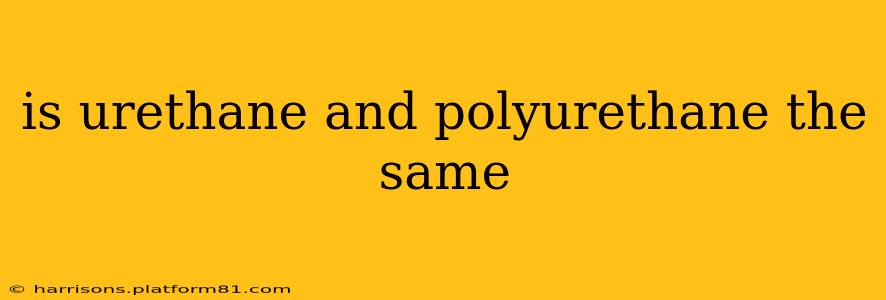Is Urethane and Polyurethane the Same? Understanding the Relationship
The short answer is: almost, but not quite. Urethane and polyurethane are closely related, often used interchangeably, but there's a subtle yet important distinction. Understanding this difference is key to choosing the right material for your specific needs.
Polyurethane is a broad family of polymers. Think of it as the overarching category. Urethane, on the other hand, is a specific chemical group within the polyurethane family. All urethanes are polyurethanes, but not all polyurethanes are urethanes. Confused? Let's break it down.
What is Polyurethane?
Polyurethane is a versatile synthetic polymer created by reacting isocyanates with polyols (polyalcohols). This reaction forms urethane linkages, which gives the resulting material its unique properties. The specific properties of the final polyurethane product depend heavily on the types and ratios of isocyanates and polyols used in the reaction. This allows for an incredibly wide range of applications.
Polyurethanes can be:
- Rigid: Used in foams for insulation, furniture, and automotive parts.
- Flexible: Found in upholstery, mattresses, and clothing.
- Elastomeric: Used in seals, gaskets, and other flexible components.
- Coatings: Applied to surfaces for protection and aesthetics.
What is Urethane?
Urethane, also known as carbamate, is a functional group—a specific arrangement of atoms—that's the characteristic feature of polyurethane. This is the key linkage in the polymer chain. The presence of the urethane group (-NH-COO-) is what gives polyurethane its name and many of its properties.
What's the Practical Difference?
In everyday conversations, and even some technical documentation, "urethane" and "polyurethane" are frequently used interchangeably. This is especially true when discussing finished products. For instance, "urethane foam" and "polyurethane foam" both refer to the same material.
However, understanding the difference becomes crucial when discussing the chemical composition and manufacturing processes. Chemists and material scientists will be precise in their terminology, while most consumers will not need the nuanced distinction.
Why the Confusion?
The confusion stems from the dominance of polyurethane materials in everyday applications. Since the characteristic chemical group responsible for many key properties is the urethane group, the name “urethane” often gets used as a shorthand.
Frequently Asked Questions (FAQs)
H2: What are the different types of polyurethane?
Polyurethane comes in many forms, depending on the starting materials and the manufacturing process. These include rigid foams (used for insulation), flexible foams (used in mattresses and furniture), elastomers (for flexible components), and coatings (for protection and aesthetics). The properties vary widely based on these differences.
H2: What are the applications of urethane?
Because "urethane" is often used as a shorthand for polyurethane, the applications are vast. You'll find it in everything from car seats and furniture to coatings on floors and insulation in buildings. Specific applications depend on the type of polyurethane in question (rigid, flexible, etc.).
H2: Is polyurethane toxic?
Some polyurethanes can release volatile organic compounds (VOCs) during and after curing, which can be harmful to human health. However, modern formulations are designed to minimize VOC emissions and meet safety standards. The toxicity also depends on the specific formulation and intended application. Always check the manufacturer's safety data sheet (SDS) for detailed information.
H2: Is polyurethane environmentally friendly?
The environmental impact of polyurethane varies depending on the specific product and its lifecycle. Some polyurethanes are recyclable, and others are designed to be more biodegradable. However, some components can be environmentally challenging to dispose of. This is an area of ongoing research and development in the industry.
H2: How is polyurethane made?
Polyurethane is made by reacting isocyanates with polyols. The specific isocyanates and polyols used, along with catalysts and additives, will influence the final properties of the polymer.
In conclusion, while the terms are often used interchangeably, understanding the difference between polyurethane (the broader polymer family) and urethane (the specific chemical group) provides a deeper understanding of this versatile and widely used material.
